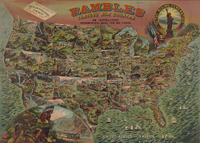April 17, 2009 -- According to the Center on Budget and Policy Priorities (external link), at least 47 states are currently facing shortfalls in their budgets, and the combined budget gap for the current and next two fiscal years is estimated to total more than $350 billion.

State partners are preserving geospatial information. Click on image for a larger version. (Image Credit: Library of Congress Prints and Photographs Division).
This issue served as a backdrop for a recent meeting of the four Preserving State Government Information initiative projects supported by the National Digital Information Infrastructure and Preservation Program. The projects met in late March at the Library of Congress to share information about efforts to preserve and provide access to important government digital information.
The Preserving State Government Information initiative focuses on capturing, preserving and providing access to a rich variety of state and local government digital information. Four lead projects work with 23 states to collect and preserve publications, geospatial data, legislative records, executive agency documents and other information of long-term value. Each project works to develop and share cost-effective tools, services and practices to help all states make progress in managing their digital heritage.
"The current budget climate has challenged our project," stated Richard Pearce-Moses, the principal investigator of the PEDALS project. "Even with that in mind," he continued, "we’ve had great success implementing the LOCKSS software and demonstrating the use and reuse of automated business rules for processing records. We know we’ll make even more progress over the coming year."
Zsolt Nagy, the principal investigator of the GeoMAPP project, noted that the transparency requirements of federal stimulus money is encouraging states to think more strategically about preservation issues. For example, Internet access to snapshots of new and superseded aerial imagery can be used to show progress on funded construction projects, and graphic displays and time-series demographic maps can show where the stimulus plan is making an impact on job numbers. "The tracking and accounting of stimulus funds in this way will prompt specialists to develop plans and improve management of superseded geospatial content, resulting in long-term access to at-risk data," he said.
The participants explored the ways in which a formal national network of digital preservation partners, comprising representatives from government, academia and the private sector, might provide benefits to its members in support of digital preservation and enhanced access. The participants also discussed the responsibility of network members, mentioning trust and participation as central concepts needed to move the potential organization forward towards success.
The network benefits manifested themselves almost immediately as participants agreed to share their state’s best practices and approaches to metadata in a future interactive meeting. They also formed a working group to explore ways to promote the work of the State government initiative through podcasts and other forms of multi-media outreach.
There are natural affinities among the state government projects that make formal networks more promising. Robert Horton, the principal investigator on the Model Technological and Social Architecture for the Preservation of State Government Digital Information project outlined an alliance with Jerry Handfield, the principal investigator of the Multi-State Preservation Consortium project.
"Jerry’s project has advanced software tools to search recorded audio files and has offered to let us test it," said Horton. "We are interested in approaches that allow us to add value without adding significant cost." Handfield noted that various states within his own project are also interested in the software. "Our entire project is focusing on developing practices that have cost-effective applicability across different states," he said.
